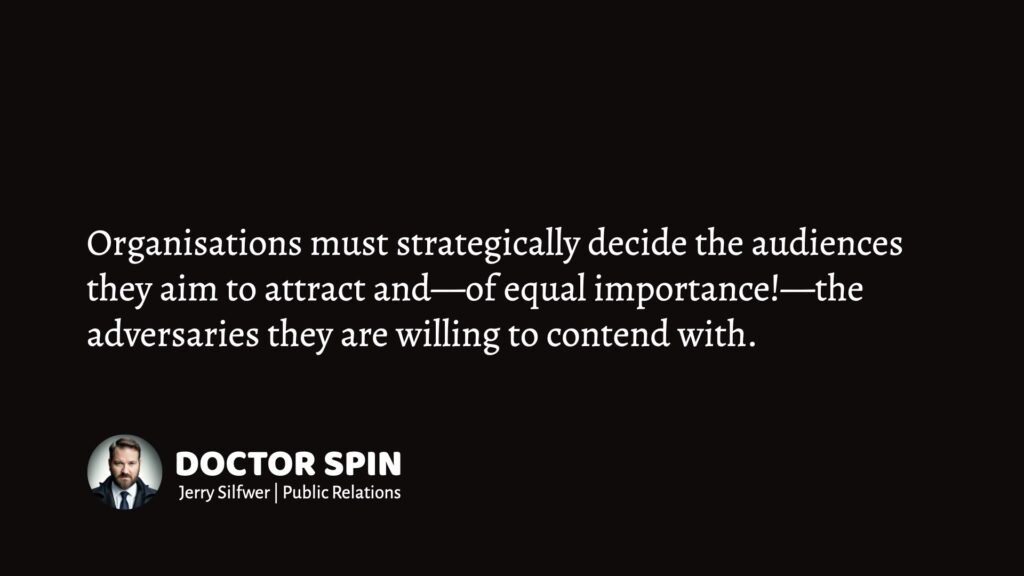The halo effect is intriguing — and ethically challenging.
Have you ever considered choosing a brand spokesperson based on their overall good looks and charisma?
While it sounds shallow, you wouldn’t be completely wrong to be tempted to base your choice on such grounds, at least in some parts.
Here we go:
The Halo Effect
In public relations, understanding and strategically using psychological phenomena can be the key to successful campaigns. One such phenomenon, the halo effect, plays a profound role in shaping public perception.
Perhaps you’ve heard of pretty privilege?
The halo effect occurs when our overall impression of a person influences our judgments of their specific traits. The effect extends beyond individual assessments and significantly impacts marketing strategies where singular characteristics often shape consumer perceptions of advertisements and brands.
“The halo effect occurs when a person’s overall positive traits influence our evaluations of individual attributes, leading to unconscious biases in judgments.”
Source: Journal of Personality and Social Psychology 1Nisbett, R., & Wilson, T. (1977). The halo effect: Evidence for unconscious alteration of judgments. Journal of Personality and Social Psychology, 35, … Continue reading
Learn more: The Halo Effect
The Halo Effect and Spokesperson Selection
For PR professionals, recognising the halo effect opens up opportunities. This phenomenon suggests that a positive general impression can produce favourable evaluations across various attributes.
“Halo effect in marketing leads people to form an entire impression based on individual characteristics, influencing their perception of advertisements, trademarks, and packaging.”
Source: Commercial Research 2Hao, L. (2004). The Analysis of Halo Effect in Marketing. Commercial Research.
This is particularly relevant in spokesperson selection. Physically attractive individuals tend to be rated more favourably regarding personality traits, a principle that can be applied in choosing brand ambassadors or public figures representing a company.
“The halo effect, also known as the physical attractiveness stereotype, refers to the habitual tendency of people to rate attractive individuals more favorably for their personality traits or characteristics than those who are less attractive.”
Source: Nursing Times 3Smith, R. (2009). Halo Effect. Nursing Times, 84 51, 68. https://doi.org/10.1007/978 – 0‑387 – 73003-5_487
The key is to create a strong, positive first impression that can colour subsequent perceptions, whether it’s through aesthetically pleasing visuals, engaging narratives, or associating the brand with admired personalities or values.
Over-Reliance on Positive Associations
While the halo effect can be a powerful tool, it presents challenges and ethical considerations. Overreliance on positive associations can lead to skewed public perceptions, potentially glossing over flaws or issues that need to be addressed.
The halo effect in lotto games shows how positive events, such as large jackpots, can temporarily boost ticket sales, overshadowing the less glamorous aspects of gambling. Similarly, PR campaigns that heavily rely on the halo effect must be careful not to mislead or create unrealistic expectations.
“The ‘Halo Effect’ in lotto games occurs when ticket sales unexpectedly increase after a large jackpot, due to bettors exchanging prize winnings for new tickets.”
Source: Applied Economics Letters 4Grote, K., & Matheson, V. (2007). Examining the ‘Halo Effect’ in lotto games. Applied Economics Letters, 14, 307 — 310. https://doi.org/10.1080/13504850500447372.
The halo effect is a double-edged sword, however. While it can be leveraged to enhance brand image and create positive associations, it requires careful handling to avoid misleading audiences.
The Paradox of Prominence
The “dark side” of what drives people’s engagement can be a true PR challenge. This phenomenon, where every strength inherently possesses a corresponding downside, can be called the paradox of prominence.

An example of this paradox is the halo effect, where physical attractiveness becomes an asset for a spokesperson. Attractiveness often leads to positive biases; attractive individuals are frequently perceived as more credible and competent. 5Eagly, A. H., Ashmore, R. D., Makhijani, M. G., & Longo, L. C. (1991). What is beautiful is good, but…: A meta-analytic review of research on the physical attractiveness stereotype. … Continue reading 6Silfwer, J. (2023, December 17). The Halo Effect: Why Attractiveness Matters in PR. Doctor Spin | The PR Blog. https://doctorspin.net/halo-effect/
However, this same attribute can spark negative reactions. Critics might claim that the individual’s success or visibility is primarily due to their looks, undermining their competencies. This duality illustrates how the qualities that draw positive attention can simultaneously attract criticism and scepticism.
Competence, another valuable trait, often encounters similar pitfalls. Highly competent individuals inspire confidence and admiration. Nevertheless, this competence can be perceived negatively when willfully interpreted as arrogance. Studies suggest that while competence garners respect, it can also lead to social penalties, such as envy and resentment. 7Fiske, S. T., Cuddy, A. J. C., Glick, P., & Xu, J. (2002). A model of (often mixed) stereotype content: Competence and warmth respectively follow from perceived status and competition. Journal of … Continue reading
Examples of the Paradox of Prominence
The paradox of prominence seems to be an inherent aspect of human interest dynamics.
| Prominence | Positive Outcome | Negative Outcome |
|---|---|---|
| Physical attractiveness | Enhanced credibility and trust | Accusations of superficial success |
| High competence | Respected and trusted as an expert | Perceived as arrogant or unapproachable |
| Charisma | Ability to inspire and attract followers | Viewed as manipulative or insincere |
| Strong advocacy | Increased support and mobilization for a cause | Target of intense criticism from opponents |
| Wealth | Seen as successful and influential | Resentment and accusations of greed or unfairness |
| Assertiveness | Effective leadership and decision-making | Labeled as domineering or aggressive |
| Innovation | Admired for creativity and forward-thinking | Resistance to change and criticism from traditionalists |
| High visibility | Greater recognition and influence | Increased scrutiny and loss of privacy |
| Generosity | Viewed as kind-hearted and philanthropic | Suspected of ulterior motives |
| Success in competitive fields | Role model and symbol of achievement | Envy and attempts to undermine accomplishments |
We must recognise that with every increase in visibility, there is a corresponding increase in scrutiny and criticism.
“Being Loved by Everyone”
Earning public awareness comes with inevitable costs.
In the quest for greater visibility and influence, it is critical to acknowledge that “being universally well-liked” is a naïve and unrealistic goal.
“Being loved by everyone” can never be a viable public relations strategy.
By strategically harnessing this paradox, public relations professionals can manage public perception by internalising expected “downsides” as additional awareness drivers.
Learn more: The Paradox of Prominence

THANKS FOR READING.
Need PR help? Hire me here.

What should you study next?
Spin Academy | Online PR Courses

Spin’s PR School: Free Psychology PR Course
Join this free Psychology PR Course to learn essential skills tailored for public relations professionals. Start now and amplify your impact on society today.
Psychology in Public Relations
Group Psychology
Learn more: All Free PR Courses
💡 Subscribe and get a free ebook on how to get better PR.

Annotations
| 1 | Nisbett, R., & Wilson, T. (1977). The halo effect: Evidence for unconscious alteration of judgments. Journal of Personality and Social Psychology, 35, 250 – 256. https://doi.org/10.1037/0022 – 3514.35.4.250 |
|---|---|
| 2 | Hao, L. (2004). The Analysis of Halo Effect in Marketing. Commercial Research. |
| 3 | Smith, R. (2009). Halo Effect. Nursing Times, 84 51, 68. https://doi.org/10.1007/978 – 0‑387 – 73003-5_487 |
| 4 | Grote, K., & Matheson, V. (2007). Examining the ‘Halo Effect’ in lotto games. Applied Economics Letters, 14, 307 — 310. https://doi.org/10.1080/13504850500447372. |
| 5 | Eagly, A. H., Ashmore, R. D., Makhijani, M. G., & Longo, L. C. (1991). What is beautiful is good, but…: A meta-analytic review of research on the physical attractiveness stereotype. Psychological Bulletin, 110(1), 109 – 128. https://doi.org/10.1037/0033 – 2909.110.1.109 |
| 6 | Silfwer, J. (2023, December 17). The Halo Effect: Why Attractiveness Matters in PR. Doctor Spin | The PR Blog. https://doctorspin.net/halo-effect/ |
| 7 | Fiske, S. T., Cuddy, A. J. C., Glick, P., & Xu, J. (2002). A model of (often mixed) stereotype content: Competence and warmth respectively follow from perceived status and competition. Journal of Personality and Social Psychology, 82(6), 878 – 902. https://doi.org/10.1037/0022 – 3514.82.6.878 |


